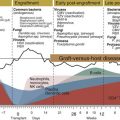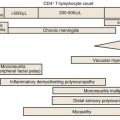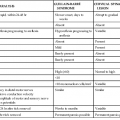Bennett Lorber
Bacterial Lung Abscess
Lung abscess results when microbial infection causes necrosis of the lung parenchyma, producing one or more cavities. These cavities often communicate with large airways, resulting in cough with purulent sputum and the presence of air-fluid levels on lung imaging studies. There may be more than one cavity, but usually one is large and dominant. The term necrotizing pneumonia (sometimes called lung gangrene) often is used to describe a similar pathologic process with multiple small (<2 cm in diameter) cavities in contiguous areas of the lung. Although many organisms may produce lung abscess, most cases are caused by anaerobic mouth microbiota and follow aspiration. Lung abscess was much more common in the preantibiotic era when, because of lack of treatment, bacterial pneumonia sometimes progressed to abscess formation, with or without empyema. Reduction in incidence also occurred in the late 1940s and 1950s, when it became clear that performing oral surgery and tonsillectomy in the sitting position was a risk factor for lung abscess, and this practice was discontinued.1 The incidence of and mortality rate from lung abscess have decreased considerably during the past several decades.
Classification
Before the wide availability of reliable methods for growing anaerobic bacteria, many patients with lung abscesses had no pathogen recovered from coughed sputum. These patients were said to have a “nonspecific lung abscess.” It is now clear that, in almost all cases, anaerobic bacteria caused these infections.
Abscesses of the lung are classified variously by the following factors: (1) the causative organism (e.g., anaerobic lung abscess or staphylococcal lung abscess); (2) the presence of a foul odor to expectorated sputum (putrid lung abscess); (3) the duration of symptoms before diagnosis (acute, symptoms present less than 1 month; chronic, symptoms present longer than 1 month); or (4) the presence or absence of associated conditions (e.g., lung cancer, acquired immunodeficiency syndrome [AIDS], immunosuppression). The term primary lung abscess generally is used when an abscess develops in individuals prone to aspiration or individuals previously in relatively good health. Secondary lung abscess indicates an obstructing airway neoplasm or foreign body, a complication of intrathoracic surgery, or a systemic condition or treatment that compromises host defense mechanisms, such as human immunodeficiency virus infection or transplantation immunosuppressive therapy. Approximately 80% of lung abscesses are primary, and roughly half of these are associated with putrid sputum.
Pathophysiology
Most lung abscesses occur as a complication of aspiration pneumonia and are polymicrobial infections caused by anaerobic bacteria that are normally present in the mouth. The bacteria that cause aspiration pneumonia2,3 and the bacteria responsible for lung abscess in aspiration-prone persons are almost identical, attesting to the role of antecedent aspiration in the pathogenesis of most lung abscesses. The initial aspiration lung insult may be due to the result of direct chemical injury from aspirated stomach acid or to areas of obstruction caused by aspirated particulate matter, such as food; secondary bacterial infection then may supervene. If the aspirated bacterial inoculum is sufficiently large or virulent, or if lung defense mechanisms are compromised, infection can occur without prior insult to the lung. Studies of animal models and patients in whom a specific time of aspiration is known have shown that tissue necrosis with lung abscess formation takes, at minimum, 1 week and usually 2 weeks to develop.4,5
The typical patient with a lung abscess has a predisposition to aspiration because of a state of altered consciousness. Common causes for altered consciousness in these patients include alcoholism (≈70%), seizures, stroke, drug overdose, and general anesthesia. In addition to increasing aspiration risk, alcohol, opiates, and anesthetic agents interfere with host defense mechanisms that protect against respiratory pathogens. Other causes for aspiration include dysphagia caused by neurologic or esophageal disease; respiratory muscle dysfunction caused by amyotrophic lateral sclerosis, Parkinson’s disease, or stroke; tooth extraction; and mechanical interference with anatomic and physiologic barriers to aspiration (e.g., nasogastric tubes and endotracheal intubation). Men outnumber women by a ratio of 5 : 1,6 perhaps related to a higher rate of alcoholism in men and the fact that men are less likely to be attentive to oral hygiene. Characteristically, patients with lung abscess have poor dentition, with gingivitis resulting in an unusually high density of oral anaerobic organisms, particularly in the gingival crevices. Lung abscess is rare in an edentulous person, and this association should raise the possibility of an airway obstruction, often caused by bronchogenic carcinoma. In some studies, almost 50% of lung abscesses in adults older than 50 years are associated with carcinoma of the lung, either because of infection behind an obstructing tumor or infection within the necrotic tumor itself. Other less common causes of airway obstruction that may lead to lung abscess include foreign bodies and extrinsic compression from an enlarged lymph node.
A study that used an isotope tracer technique to detect aspiration showed that 45% of healthy individuals aspirate during sleep, as do 70% of patients with altered consciousness secondary to disease.7 Considering that 1 mL of saliva contains 109 or more live bacteria, the infrequency of aspiration pneumonia provides strong evidence for the efficacy of the normal intrinsic lung clearance and defense mechanisms. These mechanisms may fail and pneumonia (and later abscess) ensues, when the aspirated inoculum is large, the organisms are particularly virulent, or the defense mechanisms (e.g., mucociliary apparatus, alveolar macrophages) are impaired because of intoxication or disease.
Other processes that may result in lung abscess, necrotizing pneumonia, or both include bronchiectasis, secondary infection of bland infarction from pulmonary embolism, and septic embolization from tricuspid valve endocarditis or suppurative phlebitis. Septic phlebitis of the neck veins caused by Fusobacterium necrophorum with embolic infection in the lung (Lemierre syndrome; see Chapter 65) may complicate an oropharyngeal infection, such as peritonsillar abscess. This syndrome is less likely to present with cavitary lung lesions than in the preantibiotic era.8 A distinguishing characteristic of abscesses caused by septic embolization is the involvement of multiple, noncontiguous areas of the lung.9
Aspirated bacteria are carried by gravity to dependent portions of the lung, and aspiration usually occurs with the patient in a reclining or supine position. In addition, the right main stem bronchus is larger in diameter, shorter, and less angulated from the trachea than the left main stem bronchus. Hence, lung abscesses are typically unilateral and occur most frequently in the posterior segment of the right upper lobe, followed by the same segment on the left, and then by the superior segments of the lower lobes. Spread of pulmonary parenchymal infection to the pleural space by direct extension results in empyema in one third of patients. Amebic lung abscess typically occurs in the right lower lobe, arising by direct extension of a liver abscess through the diaphragm into the pleural space and then lung (see Chapter 274).
Microbiology
Some microorganisms capable of producing lung abscess or necrotizing pneumonia are listed in Table 71-1. The predominant organisms responsible for lung abscess are bacteria, specifically oral anaerobes that are normal microbiota in the gingival crevices.5 In the presence of periodontal disease, the gingival crevice deepens and fills with anaerobic gram-negative organisms that can reach astronomical numbers (1012 colony-forming units/g of scraped gingival contents),10 similar to those in colon. Studies using sample collection techniques that avoid contamination with oral microbiota, combined with good anaerobic culture methods, have shown that anaerobes are found in about 90% of lung abscesses and are the only organisms present in about half of cases.11 The most frequently isolated anaerobes are Fusobacterium nucleatum, Prevotella melaninogenica, and Finegoldia magna (previously Peptostreptococcus magnus).12,13 Abscesses typically contain multiple anaerobe species, usually three to four per culture specimen; microaerophilic streptococci and viridans streptococci often are present as well.
TABLE 71-1
Differential Diagnosis of a Cavitary Lesion on Chest Radiograph
| Infections* |
| Bacteria |
| Septic Pulmonary Embolism |
| Mycobacteria |
| Fungi |
| Parasites |
| Noninfectious Causes |
| Neoplasms |
| Pulmonary Infarction |
| Vasculitis |
| Airway Disease |
Stay updated, free articles. Join our Telegram channel
Full access? Get Clinical Tree
 Get Clinical Tree app for offline access
Get Clinical Tree app for offline access

|





